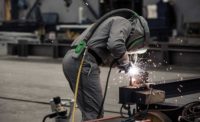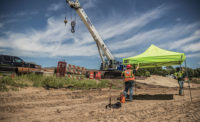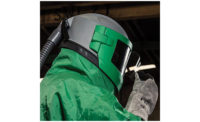NIOSH’s “Prevent Heat-Related Illness” poster (publication number 2016-151) states “Wearing PPE increases your risk for heat-related illnesses”. While this is true in a general sense, it is somewhat of a paradox because it is also true that incorporating climate control into your employees’ PPE could be the most effective way of preventing heat-related illness. Any recommendations in this article are not to contradict the poster’s information, rather to be considered as further ideas to those mentioned.
Climate control in PPE refers to those PPE items that allow your employees to improve their body temperature and work comfortably. There are many forms of climate control in PPE; with some, their very purpose is climate control, while others are general items that can be used to aid with climate control.
Types of PPE
Firstly, there is the climate control device. This is a type of flow control device used with supplied air respirators that can cool or heat incoming air to assist in maintaining a comfortable and safe body temperature. It is very effective at climate control as it includes temperature control and air flow control which the wearer can adjust as required. The one limitation with the climate control device is that it can only be used with a supplied air respirator.
Air conditioning devices are also available and can provide heating or cooling, and sometimes both. They are also a type of flow control device, but are different from the above-mentioned product in that they do not include temperature control, instead they increase or decrease the temperature by a fixed amount. These also require a supplied air respirator.
Another option is the cool vest. These are a common product and while they differ slightly between brands and products, they are typically a vest filled with a coolant that remains at a temperature of around 59˚F or 15˚C to help keep your torso cool. The cooling is effective and doesn’t require any other specific PPE, however they can add significant extra weight to your PPE.
For blasting and heavy industry, the blast jacket is a great option for climate control. A blast jacket attaches to your respirator and any excess air flowing into your respirator then flows down your torso and arms to help cool your upper body. Cool air (using a climate control device or air conditioning device as described above) is obviously most effective with the blast jacket, but even if the air is not temperature controlled, air flowing over your body provides cooling.
Coveralls can be used in conjunction with an air supplied respirator (supplied air or powered air) that can either connect to the coveralls or has an internal, tuck-in collar or bib, provide cooling similar to a blast jacket.
Illness can be prevented
The most important role of climate control in PPE is to protect your employees from any form of heat stress that can have life changing or even life-threatening effects. When the combined temperature of your body and the environment you are in reaches levels where your body can’t regulate its heat gain though sweating, you can develop heat cramps, which is a mild form of heat-related illness. This is usually accompanied by fatigue, heavy sweating, muscle cramps and thirst. If promptly treated by drinking water and resting in a cool place, further illness can be prevented. If ignored, however, this can develop into heat exhaustion where symptoms can include that of heat cramps plus confusion, nausea or vomiting, headache, dizziness and fainting.
The worst form of heat stress is heat stroke (a type of hyperthermia) where your body may stop sweating, collapse and seizure. This is life-threatening and requires immediate medical attention. The purpose of climate control in PPE is to assist your body in maintaining a safe and comfortable temperature so that even the mildest forms of heat stress don’t occur.
Comfort is key
Whether it be an increase or decrease in temperature required, it is important that your employees are comfortable. Comfort is viewed by many PPE developers and manufacturers, employers and employees as secondary to safety, but comfort is safety. The more comfortable your employees are, the more likely they can make good and safe decisions. Or to look at it from the negative perspective, uncomfortable employees are a lot more likely to lose focus and not pay enough attention to their often-dangerous job
and surroundings, make bad and unsafe decisions, or subconsciously violate safety measures and risk harming themselves.
Another reason to ensure your employees have climate control in their PPE to maintain comfort is productivity. Comfort allows employees to operate at maximum. While this does not directly affect anyone’s life or health, it is in the best interest of employers to ensure their employees are comfortable so they can operate at maximum productivity.
Conclusion
Climate control in PPE assists your body in maintaining a safe and comfortable temperature. This is important because it plays a key role in preventing heat and cold related illness, which can be life changing or life threatening for your employees. It is also imperative for maximized safety and productivity.
Advice for anyone buying PPE and considering climate control is to know and understand your options because everyone’s environment, requirements and investment possibilities are different. Speak with manufacturers, read reviews and do product trials when possible. The perfect climate control solution for you is out there; and finding it will pay off.



